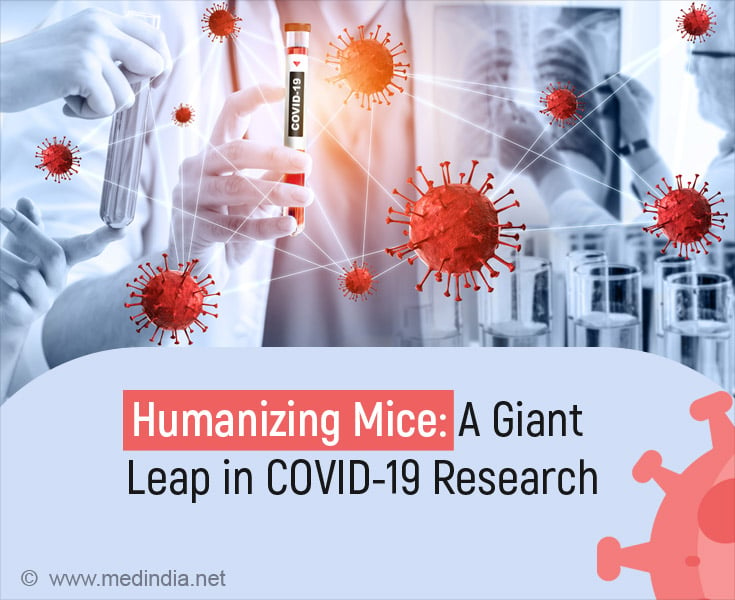The new study, led by experts from NYU Grossman School of Medicine, developed lab mice with human genetic material for ACE2 – a
captured by the pandemic virus so that it may attach to human cells as part of the infection. Instead of dying upon infection, the mice with this genetic alteration showed symptoms identical to young humans infected with the virus that causes COVID-19.
“That these mice survive creates the first animal model that mimics the form of COVID-19 seen in most people – down to the
cells activated and comparable symptoms,” said senior study author Jef Boeke, the Sol and Judith Bergstein Director of the Institute for Systems Genetics at NYU Langone Health. “This has been a major missing piece in efforts to develop new drugs against this virus.”
“Given that mice have been the lead genetic model for decades,” added Boeke, “there are thousands of existing mouse lines that can now be crossbred with our humanized ACE2 mice to study how the body reacts differently to the virus in patients with diabetes or obesity, or as people age.”
Advertisement
The latest research relies on a novel approach to editing DNA, the 3 billion “letters” of the genetic code that serve as instructions for the construction of our cells and bodies.
Building Living Mice with Cells that Have More Human-Like Levels of ACE Gene
While well-known tools such as CRISPR allow for the editing of DNA one or a few letters at a time, other challenges necessitate alterations across genes that can be up to 2 million letters long. In such circumstances, building DNA from scratch may be more efficient, with far-flung alterations made in big swathes of code pre-assembled and then swapped into a cell in place of its natural equivalent. Because human genes are so complex, Boeke’s group began its “genome writing” approach in yeast, which is a one-celled fungus that shares many characteristics with human cells but is simpler and easier to analyze.
More recently, Boeke’s team applied its yeast approaches to the mammalian genetic code, which is made up of many switches that turn on different genes at varying degrees in different cell types as well as genes that encode proteins. For the first time, the research team was able to build living mice with cells that had more human-like levels of ACE gene activity by researching this poorly understood “dark matter” that regulates genes. The researchers employed yeast cells to build DNA sequences of up to 200,000 letters in a single step, and then used their unique delivery technology, mSwAP-In, to deliver these “naked” DNAs into mouse embryonic stem cells.
By “overwriting” 72 kilobases (kb) of mouse Ace2 coding with 180 kb of the human ACE2 gene and its regulatory DNA, mSwAP-In delivered a humanized animal model of COVID-19 disease.
Novel Stem Cell Approach to Enable Human-Mice Exchange of DNA
To achieve this cross-species exchange, the researchers removed a vital area in the DNA code around the natural gene, swapped it in a synthetic equivalent in stages, and added a quality control mechanism with each addition so that only cells carrying the synthetic gene survived. The researchers then collaborated with Sang Yong Kim at NYU’s Rodent Genome Engineering Lab to construct a living mouse with overwritten genes using a stem cell approach known as “tetraploid complementation.”
Furthermore, the researchers had earlier developed and switched into mouse cells a synthetic version of the gene Trp53, the mouse analog of the human gene TP53. This gene’s protein controls the cell’s reaction to broken DNA and can even direct cells containing it to die to prevent the accumulation of malignant cells. When this “guardian of the genome” becomes defective, it contributes significantly to human malignancies. Unlike the ACE2 trials, which used an unmodified form of a human gene, the synthetic, swapped-in Trp53 gene was designed to eliminate a combination of molecular code letters – cytosine (C) next to guanine (G) – known to be susceptible to random, cancer-causing mutations. The researchers replaced crucial CG “hotspots” with coding containing a different adenine (A) DNA letter.
“The AG switch left the gene’s function intact, but lessened its vulnerability to mutation, with the swap predicted to lead to a 10-to-50 fold lower mutation rate,” said first author Weimin Zhang, PhD, a post-doctoral scholar in Boeke’s lab. “Our goal is to demonstrate in a living test animal that this swap leads to fewer mutations and fewer resulting tumors, and those experiments are being planned.”
Reference :
- Mouse genome rewriting and tailoring of three important disease loci – (https:www.nature.com/articles/s41586-023-06675-4)
Source: Medindia



